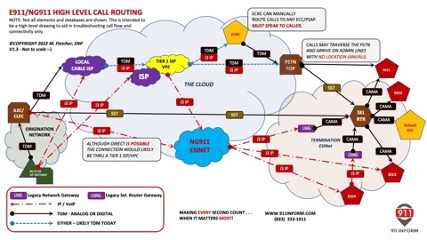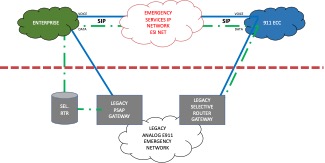In an emergency, for Public Safety first responders to be able to locate you, should you call 911, you need to provide the information they would need to locate you. This is commonly referred to as a Dispatchable Location. As of January 6 of last year, federal law under the US Code of Federal Regulations requires it under CFR 47 Part 9 (et. seq). Failure to provide this information carries a penalty of up to $10,000 and $500 per day per occurrence.
Unfortunately, today’s new hybrid work environment creates a telecommunications management problem. Users are increasing their nomadic behavior, splitting their time between working from home and their typical office. But what’s the issue with this? Why is this suddenly a problem? The answer is quite simple. VoIP telephone devices have become inherently nomadic. Physical VoIP phones are easily transported from one location to another, and softphones reside on cell phones, tablets, and laptops, all nomadic by nature with constant changing locations.
The Current Complication with E911
This nomadic behavior exasperates the location reporting problem because the current E911 network uses the caller’s telephone number (TN) as an index key to reference a user’s location information out of a repository database. In addition to being something that has to be retrieved at the time of the emergency for current information, this only works if there is a single instance of the device. If multiple instances of the device exist at different locations (such as a desk phone in multiple buildings or a desk phone and a softphone on a laptop), the following issues arise:
- The Dispatchable Location information must be device-specific.
Devices not sharing a physical location cannot share a 911 location database record.
- Device location detail
For locations inside of complex commercial facilities, the information provided in the ANI/ALI record must include information specific enough to locate you in the facility. Best practices recommend that this includes the following- Building street address
- Floor
- Location description information detail
The ANI/ALI Database doesn’t even include the appropriate fields to hold this location information. The single freeform Address Line 2 field is only 30 characters in most ANI/ALI systems used by ECCs.
- The E911 record must be adjusted to reflect the user’s current location.
While that capability is possible using several 3rd party database management spftware programs, the location must still be automatically detected, validated, and then the ANI/ALI database update needs to be submitted. This update process, which may take several days to become active, must complete before the updated information is visible to 911 call takers when the number is queried. For continuously moving users, the location associated with the TN record may never reflect an accurate user address.
- Each active device requires a unique E911 ANI/ALI record.If you are on a softphone at your home, with an updated address for your TN, and your desk phone at the office is still active, anyone using the office phone for 911 will inaccurately report your home address. Likewise, if your TN reflect the location of your desk phone, your laptop at a remote location will all inaccurately report your office address.
- Non-DID devices now REQUIRE Unique DID Numbers Assigned to Them
To report a unique location, a unique TN must be assigned on each station, dialing 911. This requires unique ANI/ALI Records for each device, a database management solution for the environment, and often an FTE to manage the entire solution for internal, external, and remote workers utilizing the system.
Dispatchable Location Granularity – Reporting Location for 911 Calls

Think of it this way, if you wanted to send a package to me at my office, you wouldn’t be able to provide “Fletch at 911inform, LLC” to the delivery company. You would need to provide a complete street address, 1709 Highway 34. Since we are just one tenant of several in that facility, ‘Suite 3A’ would be provided as additional information required to ensure delivery to the proper suite. In a larger facility, more information may be required to assist internal staff in properly delivering the package.
For example, the BEST information specificity to ensure prompt and accurate delivery would look something like this:
911inform, LLC
1709 Highway 34
Suite 3A
Wall, New Jersey 07727
Attn: Mark J. Fletcher, ENP – Mailstop 2C231
ELINs – Yesterday’s Affordable fix for Legacy 911
Balancing cost versus location accuracy has been initially addressed using the concept of an ELIN, or Emergency Location Identification Number. ELINs have been an affordable stopgap for reducing the number of DIDs required, but they don’t come without functionality degradation. Over the last two decades, ELINs have allowed stations with similar location details to be ‘consolidated’ under a single shared reporting number. This shortcut provided slightly more granular reporting to a floor or a zone in a larger facility. It also provided more precise station information detail to internal resources, who would then direct 1st responders to the location of the incident. Over the last two decades, this provided an acceptable stopgap while NG911 has undergone its final development stages. However, first responders were deprived of specific station detail, creating discrepancies in certain edge cases.
Affordable NG911 – Without Sacrificing Precise Accuracy to Public Safety
NENA, the National Emergency Number Association, is an accredited ANSI standards body responsible for the NENA i3 Standard for Next Generation 9-1-1.
Version 3 of the current i3 standard includes critical updates to NG9-1-1 infrastructure to ensure continued support for interoperability on a national and even international scale. Specific Version 3 changes include a move to a REST/JSON architecture for data interactions between functional elements and core systems, improvements to security, significant updates to the call bridging (Bridging Service), Discrepancy Reports to support FCC penalties for errant reporting, an Outgoing Call Interface Function, blind transfer support, updates to novel call types (including non-interactive calls and Advanced Automatic Crash Notifications [AACNs]), and more.
Version 3 also incorporates several new IETF specifications and has made adjustments to addressing to harmonize the data specifications across Europe and North America.
i3 remains an open standard developed with the contribution of a large community of industry, academic, and public safety experts. NENA’s development process is always open to all with more information available on the NENA i3 NG9-1-1 standard page available on http://nena.org. (https://www.nena.org/general/custom.asp?page=i3_stage3)
NG911 Availability Across the US
With NG911 becoming more well-known and customers going through system upgrades for Kari’s Law and RAY BAUM Act compliance, the natural question is, “Will I need to go through this again for NG911?” Fortunately, the answer to that question can be “NO!” with proper planning and implementation.
NG911 is extraordinarily complex and not for the faint at heart. It requires expertise across a broad set of skill sets requiring specific certifications and training. To give you and idea of the complexity, even THIS architecture is not a complete representation, but one that has enough detail to discuss call routing and delivery.

NG911 at a High Level – A Modular Functionality
Indeed, an enterprise support engineer must understand the NG911 network, but only partially. What Enterprises need to digest is quite simple and consumable. This is because NG911 is based on current IP functionality and standard protocols. At a core level, basic connectivity is no different from any other Client/Host data application, and anyone with basic-level network application skills can learn what they need in a short time. Simplifying the network complexity is easily accomplished by focusing on the Enterprise network and its connectivity to the Emergency Services IP network. Adding in the Emergency Communications Center as the destination and the ESI Net is simply the SIP Core network connecting two peer SIP entities passing calls and data between each other.

Transitional Connection to an ESI Net
Today you may be in an area where you have been told NG911 is ‘years away’ or not on the current roadmap for your local ECC. Typically, this would be a design concern, but fortunately, the architecture of NG911 provides you with a mechanism for connectivity. The savings introduced here is the dynamic ability to provide real-time location information of the calling device AT THE TIME OF THE CALL IN REAL-TIME! This eliminates the complexity of database updates and bypasses the legacy aspect of the E911 network that is being decommissioned.
The benefit here is that once this upgrade is done in the ENTERPRISE – Your solution is functioning as an NG911 solution now, being downgraded if need be by the NG911 carrier for proper delivery to your ECC. You no longer need to track or worry about the network, as your emergency traffic is being harmonized with the receiving ECC in the ESINet. Currently, this capability is only available with the Bandwidth Carrier solution when using the 911inform platform. However, market demand due to the lower operational cost and deployment flexibility is driving the other three carriers to develop this new capability despite their attempts to promote the legacy technology, likely due to higher margins on that service.

The Benefit of Investing in NG911 Today
If your local 911 Public Safety Answer Point or ECC is NG911 or not, or you are an Enterprise user remediating for Kari’s Law or the RAY BAUM’S Act, at this point, the intelligent move is to invest in an NG911 solution to protect and future proof your enterprise’s network by migrating your Emergency Services connectivity now. Trustworthy Tier 1 NG911 IP carriers offer connectivity and services today that will significantly reduce the operational overhead, complexity, and overall expense for emergency services.
BUYER BEWARE!
When shopping for any carrier services, remember divestiture? After the Bell System breakup, anyone could become a carrier by buying services and reselling them. The same is true with NG911 carriers. With this being a life safety service, at this point, I would recommend contracting only with one of the 4 Tier 1 players and make sure the account team engages a 911 expert. I recommend looking for someone with the NENA ENP certification, or at a minimum, an APCO RPL designation, to be available to the account team.
Today, Tier 1 providers are limited to just four players. If you’re not contracting with one of them, it is a secondary provider reselling services of another Tier 1 carrier.
These current Tier 1 NG911 NGCS Service Providers are:
Bandwidth ComTech
Inteliquent Intrado
Enterprise Solutions Matter as Well
When choosing an Enterprise-class solution for Kari’s Law and RAY BAUM’S Act compliance to satisfy your requirements under US CFR 47 Part 9 (et. seq), be sure that the provider understands NG911 as well, and make sure an ENP is engaged with your account team to ensure proper guidance is being provided.
At 911inform, we are very serious about the proper and accurate compliance nuances around Enterprise NG911 to ensure that we live up to our core value to ‘Make Every Second Count, When it Matters Most™’.
I hope you find my blogs informative, please remember to follow me on Twitter @Fletch911,
Most of my posts and articles are available on LinkedIn,
and I also have a page on Facebook.
I am a current candidate for the NENA Northeast Region Director position, and my campaign webpage is located at http://fletch911.com. NENA members in Maine, New Hampshire, Vermont, Rhode Island, Massachusetts, Connecticut, New York, New Jersey, Pennsylvania, West Virginia, Virginia, and the District of Columbia are encouraged to vote in the upcoming elections on March 15th. See my webpage http://fletch911.com, or the http://NENA.org website for full details.


